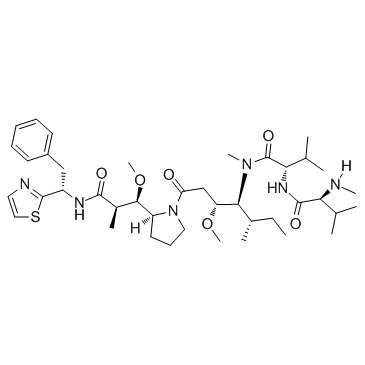203849-91-6
| Name | Monomethylauristatin D |
|---|---|
| Synonyms |
N-Methyl-L-valyl-N-[(3R,4S,5S)-3-methoxy-1-{(2S)-2-[(1R,2R)-1-methoxy-2-methyl-3-oxo-3-{[(1S)-2-phenyl-1-(1,3-thiazol-2-yl)ethyl]amino}propyl]-1-pyrrolidinyl}-5-methyl-1-oxo-4-heptanyl]-N-methyl-L-valinamide
L-Valinamide, N-methyl-L-valyl-N-[(1S,2R)-2-methoxy-4-[(2S)-2-[(1R,2R)-1-methoxy-2-methyl-3-oxo-3-[[(1S)-2-phenyl-1-(2-thiazolyl)ethyl]amino]propyl]-1-pyrrolidinyl]-1-[(1S)-1-methylpropyl]-4-oxobutyl]-N-methyl- MFCD25976743 Demethyldolastatin 10 Monomethylauristatin D Monomethyl Dolastatin 10 MMAD |
| Description | MMAD is a potent tubulin inhibitor, is a toxin payload in antibody drug conjugates (ADCs). |
|---|---|
| Related Catalog | |
| Target |
Tubulin[1] |
| In Vitro | MMAD (Monomethyl Dolastatin 10) is coupled through a stable oxime-ligation process to yield several near-homogenous antibody-drug conjugates (ADCs) with a drug-to-antibody ratio of ~2.0. The resulting conjugates demonstrate good pharmacokinetic properties, potent in vitro cytotoxic activity against HER2+ cancer cells. When compared with ADCs prepared by cysteine alkylation following native interchain disulfide reduction, site-specific unnatural-amino-acid-based ADCs are shown to have increased in vitro cytotoxicity[1]. |
| In Vivo | The resulting antibody-drug conjugates (ADCs) demonstrate complete tumour regression in rodents. They also have an improved toxicology profile in rats[1]. |
| References |
| Density | 1.1±0.1 g/cm3 |
|---|---|
| Boiling Point | 906.1±65.0 °C at 760 mmHg |
| Molecular Formula | C41H66N6O6S |
| Molecular Weight | 771.064 |
| Flash Point | 501.8±34.3 °C |
| Exact Mass | 770.476440 |
| LogP | 5.82 |
| Vapour Pressure | 0.0±0.3 mmHg at 25°C |
| Index of Refraction | 1.537 |
| Storage condition | 2-8℃ |
